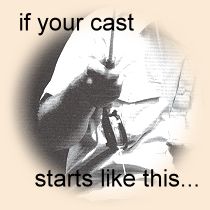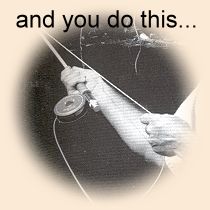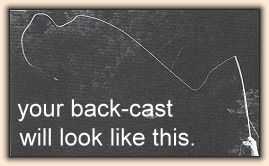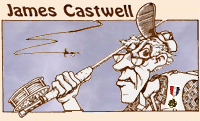|
If there were three-hundred and seventy-three new guys casting
there would be three-hundred and seventy-three most common
casting faults, we are inventive. We are not satisfied with
everyone else's casting problems, we want our own, so we make
them up. For you guys new to casting (spring is coming, you
better get out and practice casting) here is a way to perhaps
get on the fast-track.
Have you had this happen to you yet when you are out casting?
You make a few casts and then something happens . . . the cast
goes real good. You wonder what the heck you did that caused it?
If not, wait, it will happen if you are even nearly human. All at
once, a few of the right things happen together and the line shoots
out like you were a pro. When it does, try to figure out what it
was you did and repeat it if possible. Here is one thing that may
he helpful.
 Often when bringing the rod back from the forward cast a guy
will twist the reel out to the right side instead of having
it be on top of the reel-seat where it should be. This twisting
is usually caused by watching the line and rod as they go back
into the back-cast. It causes the line to take a wider course
going back, often a wobbly loop off to the side which slows
down the line and robs the cast of power.
Often when bringing the rod back from the forward cast a guy
will twist the reel out to the right side instead of having
it be on top of the reel-seat where it should be. This twisting
is usually caused by watching the line and rod as they go back
into the back-cast. It causes the line to take a wider course
going back, often a wobbly loop off to the side which slows
down the line and robs the cast of power.

To get, and maintain, your line speed, on a few casts, watch
your reel to make sure it goes from being under the rod on the
start of the back-cast, to on top of the rod when you stop at
the end of the back-cast. This will give you the shortest
distance for the line to travel and will therefore be the most
efficient form. Your line will probably go over the top of the
rod too. If you are swinging your reel out try this. Bring the
rod back straight toward your nose. This will keep you from
swinging it out, and also shorten your stroke which probably
will be a good thing at this point as well. Make a few casts
this way, then move your arm out to the right and keep casting
using the same exact stroke.
You can also bring the rod to the left side of your face or left
ear. This is not a bad cast to practice and will help in correcting
the reel twisting problem. Sometimes a caster will be just fine
at twenty feet or so, but when trying for longer casts will open
up and swing the reel out. If you have to, try actually twisting
your right hand a bit toward you when coming back with the rod
from in front of you. This will twist it some and help keep the
reel in the right plane. You should always try to keep the reel
on top of the rod when you make the stop on the back-cast. It
is not always an easy thing to do, especially when going for
very long distances, but with practice you will get better at
it if you try, and now you know at least one right thing to
try. If your back-cast looks like this, it can be better.

Have fun. ~ James Castwell
|





